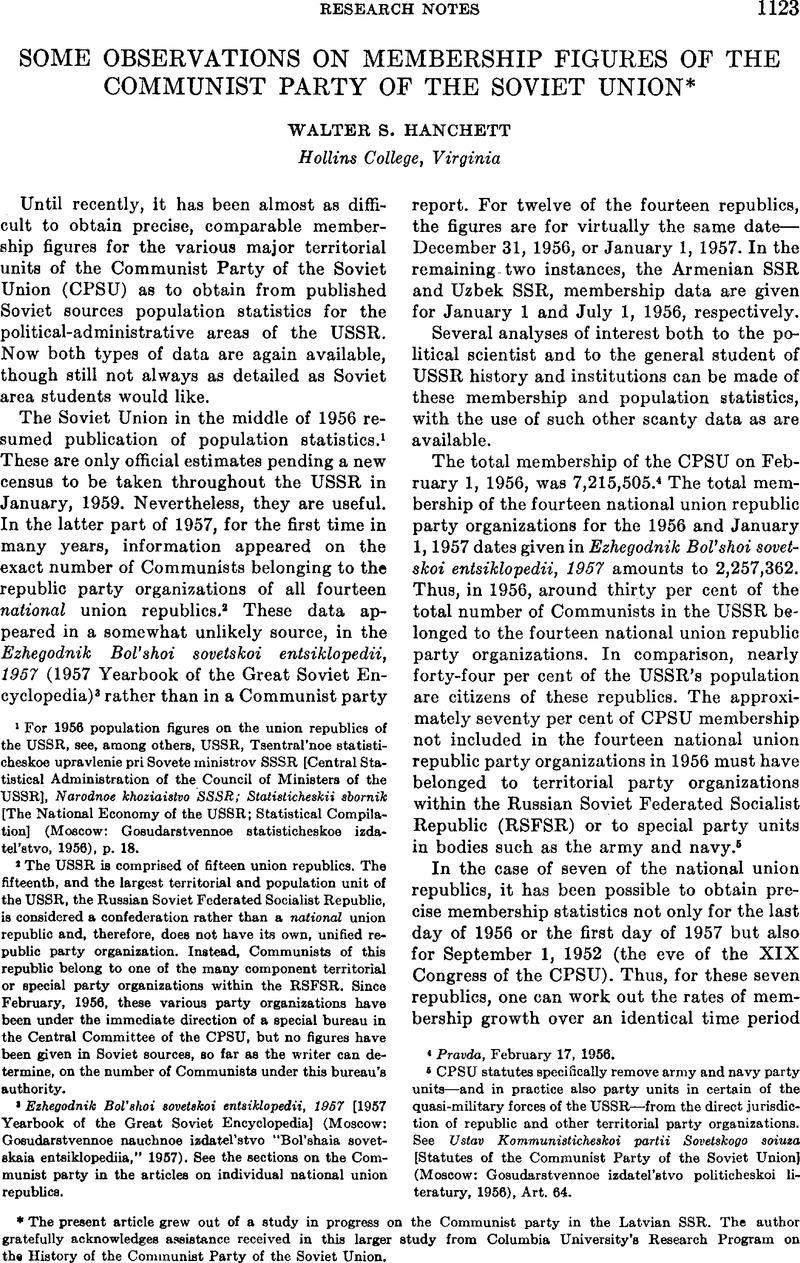No CrossRef data available.
Article contents
Some Observations on Membership Figures of the Communist Party of the Soviet Union*
Published online by Cambridge University Press: 02 September 2013
Abstract

- Type
- Research Notes
- Information
- Copyright
- Copyright © American Political Science Association 1958
References
1 For 1956 population figures on the union republics of the USSR, see, among others, USSR, Tsentral'noe statisticheskoe upravlenie pri Sovete ministrov SSSR [Central Statistical Administration of the Council of Ministers of the USSR], Narodnoe khoziaistvo SSSR; Statisticheskii sbornik [The National Economy of the USSR; Statistical Compilation] (Moscow: Gosudarstvennoe statisticheskoe izdatel'stvo, 1956), p. 18Google Scholar.
2 The USSR is comprised of fifteen union republics. The fifteenth, and the largest territorial and population unit of the USSR, the Russian Soviet Federated Socialist Republic, is considered a confederation rather than a national union republic and, therefore, does not have its own, unified republic party organization. Instead, Communists of this republic belong to one of the many component territorial or special party organizations within the RSFSR. Since February, 1956, these various party organizations have been under the immediate direction of a special bureau in the Central Committee of the CPSU, but no figures have been given in Soviet sources, so far as the writer can determine, on the number of Communists under this bureau's authority.
3 Ezhegodnik Bol'shoi sovetekoi entsiklopedii, 1957 [1957 Yearbook of the Great Soviet Encyclopedia] (Moscow: Gosudarstvennoe nauchnoe izdatel'stvo “Bol'shaia sovetskaia entsiklopediia,” 1957)Google Scholar. See the sections on the Communist party in the articles on individual national union republics.
4 Pravda, February 17, 1956.
5 CPSU statutes specifically remove army and navy party units—and in practice also party units in certain of the quasi-military forces of the USSR—from the direct jurisdiction of republic and other territorial party organizations. See Ustav Kommunisticheskoi partii Soveiskogo soiuza [Statutes of the Communist Party of the Soviet Union] (Moscow: Gosudarstvennoe izdatel'stvo politicheskoi literatury, 1956)Google Scholar, Art. 64.
6 In 1956, these four republic party organizations accounted for less than four per cent of the total membership of the CPSU.
7 The statutes of the CPSU provide for such transfer of membership when Communists move from one area to another. See Ustav Kommunisticheskoi partii Sovetskogo soiuza (1956), Art. 8.
8 “Ukrainskaia sovetekaia sotsialisticheskaia respublika” [Ukrainian SSR], Bol'shaia sovetskaia entaiklopediia (2d ed.), Vol. XLIV, p. 104Google Scholar, and “Ukrainskaia sovetskaia sotsialisticheskaia respublika,” Ezhegodnik Bol'shoi sovetskoi entsiklopedii, 1957, p. 208Google Scholar.
9 Ustav Kommunisticheskoi partii Sovetskogo soiuza (1956), Art. 18.
10 Pravda, August 20, 1952, and July 14, 1955.
11 Pravda, October 9, 1952; Bumber, I. A. F. and Alampiev, P. M. (eds.), Latviiskaia SSR; Ocherki ekonomicheskoi geoffrafii [Latvian SSR; Studies in Economic Geography] (Riga: Izdatel'stvo Akademii nauk Latviiskoi SSR, 1956), p. 98Google Scholar; and “Latviiskaia sovetskaia sotsialiaticheskaia respublika” [Latvian SSR], Bol'shaia sovetskaia entsiklopediia (2d ed.), Vol. XXIV, p. 331Google Scholar.
12 Sovetskaia Latviia, January 20, 1956; “Latviiskaia sovetskaia sotsialisticheskaia respublika,” Ezhegodnik Bol'shoi sovetskoi entsiklopedii, 1957, p. 148Google Scholar; and “Latviiskaia sovetskaia sotsialisticheskaia respublika,” Bol'shaia sovetskaia entsiklopediia (2d ed.), Vol. XXIV, p. 331Google Scholar.



Comments
No Comments have been published for this article.